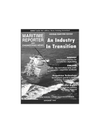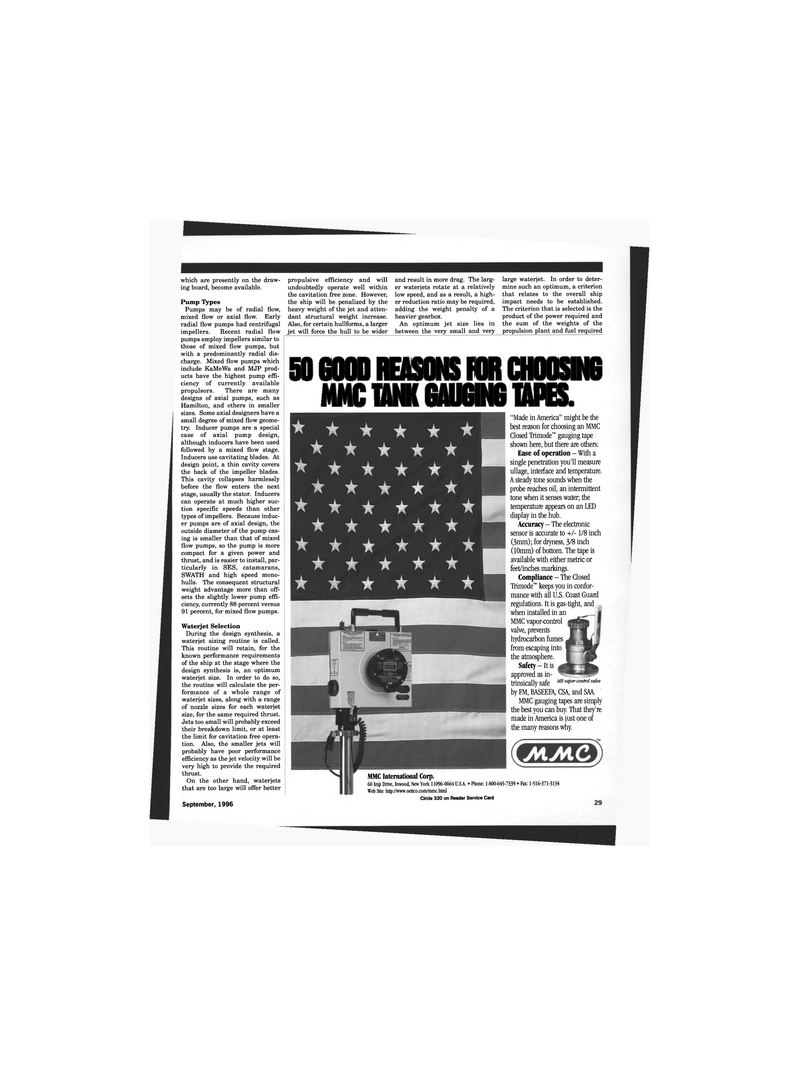
Page 27: of Maritime Reporter Magazine (September 1996)
Read this page in Pdf, Flash or Html5 edition of September 1996 Maritime Reporter Magazine
which are presently on the draw- ing board, become available.
Pump Types
Pumps may be of radial flow, mixed flow or axial flow. Early radial flow pumps had centrifugal impellers. Recent radial flow pumps employ impellers similar to those of mixed flow pumps, but with a predominantly radial dis- charge. Mixed flow pumps which include KaMeWa and MJP prod- ucts have the highest pump effi- ciency of currently available propulsors. There are many designs of axial pumps, such as
Hamilton, and others in smaller sizes. Some axial designers have a small degree of mixed flow geome- try. Inducer pumps are a special case of axial pump design, although inducers have been used followed by a mixed flow stage.
Inducers use cavitating blades. At design point, a thin cavity covers the back of the impeller blades.
This cavity collapses harmlessly before the flow enters the next stage, usually the stator. Inducers can operate at much higher suc- tion specific speeds than other types of impellers. Because induc- er pumps are of axial design, the outside diameter of the pump cas- ing is smaller than that of mixed flow pumps, so the pump is more compact for a given power and thrust, and is easier to install, par- ticularly in SES, catamarans,
SWATH and high speed mono- hulls. The consequent structural weight advantage more than off- sets the slightly lower pump effi- ciency, currently 88 percent versus 91 percent, for mixed flow pumps.
Waterjet Selection
During the design synthesis, a waterjet sizing routine is called.
This routine will retain, for the known performance requirements of the ship at the stage where the design synthesis is, an optimum waterjet size. In order to do so, the routine will calculate the per- formance of a whole range of waterjet sizes, along with a range of nozzle sizes for each waterjet size, for the same required thrust.
Jets too small will probably exceed their breakdown limit, or at least the limit for cavitation free opera- tion. Also, the smaller jets will probably have poor performance efficiency as the jet velocity will be very high to provide the required thrust.
On the other hand, waterjets that are too large will offer better
September, 1996 29 propulsive efficiency and will undoubtedly operate well within the cavitation free zone. However, the ship will be penalized by the heavy weight of the jet and atten- dant structural weight increase.
Also, for certain hullforms, a larger jet will force the hull to be wider and result in more drag. The larg- er waterjets rotate at a relatively low speed, and as a result, a high- er reduction ratio may be required, adding the weight penalty of a heavier gearbox.
An optimum jet size lies in between the very small and very large waterjet. In order to deter- mine such an optimum, a criterion that relates to the overall ship impact needs to be established.
The criterion that is selected is the product of the power required and the sum of the weights of the propulsion plant and fuel required 50 GOOD REASONS FOR CHOOSING
MMC TANK GAUGING TAPES.
MMC International Corp. 60 Inip Drive, Inwood, New York 11096-0664 U.S.A. • Phone: 1-800-645-7339 • Fax: 1-516-371-3134
Web Site: http://www.oettco.com/mmc.html
Circle 320 on Reader Service Card "Made in America" might be the best reason for choosing an MMC
Closed Trimode™ gauging tape shown here, but there are others:
Ease of operation - With a single penetration you'll measure ullage, interface and temperature.
A steady tone sounds when the probe reaches oil, an intermittent tone when it senses water; the temperature appears on an LED display in the hub.
Accuracy - The electronic sensor is accurate to +/-1/8 inch (3mm); for dryness, 3/8 inch (10mm) of bottom. The tape is available with either metric or feet/inches markings.
Compliance - The Closed
Trimode™ keeps you in confor- mance with all U.S. Coast Guard regulations. It is gas-tight, and when installed in an
MMC vapor-control valve, prevents hydrocarbon fumes from escaping into the atmosphere.
Safety-It is approved as in- trinsically safe MB mP°r-contr°l vdve by FM, BASEEFA, CSA, and SAA.
MMC gauging tapes are simply the best you can buy. That they're made in America is just one of the many reasons why.

 26
26

 28
28
